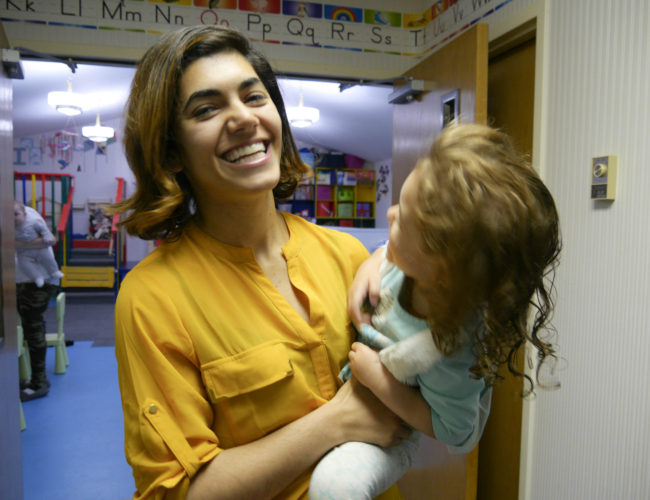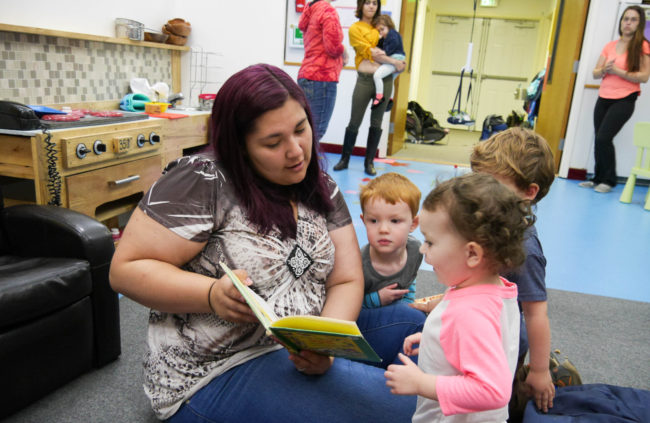
Licensed child care availability is up 21 percent in Juneau compared with last year, according to a local organization.
Child care providers and its supporters say that’s good news for a market that historically has struggled to meet demand.
Joy Lyon is the executive director the Association for the Education of Young Children, a Juneau-based organization that researches and provides services for child care in Southeast Alaska.
“We’re really excited that now we 21 percent more child care spaces than we did last year, at this time, so there’s an increase of 80-some spaces that is the result of three different initiatives.”
One of the big initiatives relaxed city zoning rules that apply to child care centers, which the Juneau Assembly passed late last year.
One change let at-home child and day care providers have up to 12 children, instead of eight, without needing a permit from the city.
“The zoning laws have led to four new group homes, so they’re able to provide support for more children,” Lyon said. “That’s the model we hope to encourage for the other 30 family child care providers, and then two new centers have started since last year, which has led to the increase. One of the centers would not have been able to start without that change to the zoning laws.”
That center is the Gehring Nursey School.

On a recent morning there, about a dozen babies and children are running around, eating snacks and preparing to paint. Some are crowding in a circle to listen for an impromptu story time.
The five women that work at the day care also have their own children here. One teacher says watching her children grow up while working is a bonus.
Amy Myers is an administrator at the daycare. After getting pregnant two years, she says one of her first thoughts was: What about child care?
“I heard that there were waitlists for pretty much every day care,” she said, “and then not only were there waitlists for child care, there were no infant spots.”
She says if you’re lucky, the search starts early.
“So really it’s that moment you find out you’re pregnant, you have to get on a waitlist for somewhere,” Myers said.
Myers decided to be a stay-at-home mom, and eventually started working at the day care center.
Issy Kako-Gehring runs the center and says just two years ago, it couldn’t have existed under the city’s zoning rules for child care providers.
In 2014, she says she began meeting with Juneau Republican Rep. Cathy Muñoz and Juneau Assembly member Jesse Kiehl to address the issue. Those meetings eventually led to the zoning changes.
Two other initiatives have also contributed to additional childcare availability, Lyon said.
The first is the Hiring, Educating and Retaining Teaching Staff, or HEARTS initiative, which the city sponsors. The program’s goal is to the provide educational resources and help retain child care teachers.
The second initiative is a $1,000 grant that Lyon’s organization offers to new child care startups.
Kako-Gehring said families turning over is another factor.
“Part of that reason, I think, is that a lot of families are moving,” she said. “We’ve had at least 10 families in the last year, to move out of state, young families.”
Juneau has an aging community and the cost of child care here forces families to make important decisions, she said.
For mothers, she said, do you work and pay a thousand dollars a month for your child to be in day care, or do you stay home and watch them grow up?
“There’s a lot that’s involved in this 21 percent and it has to be looked at from every angle,” she said. “The 21 percent increase could also mean that less women are in the workforce.”
Kako-Gehring said her day care isn’t at capacity. That’s a good thing, she said; her workers aren’t overwhelmed. But when they do open a spot — it’s filled almost immediately.
A few other child care centers I called in Juneau had long waiting lists, too, especially for infants. But for the first time in five years, child care capacity in Juneau is rising.
